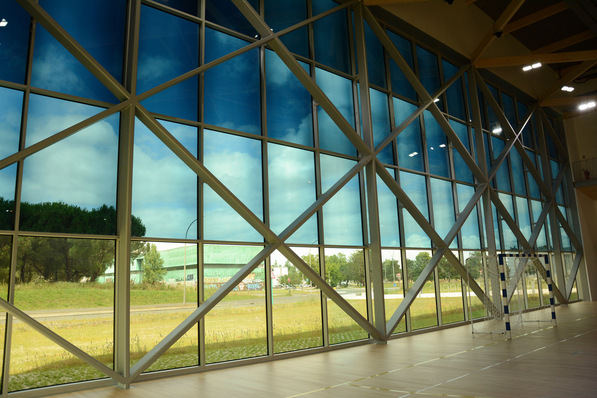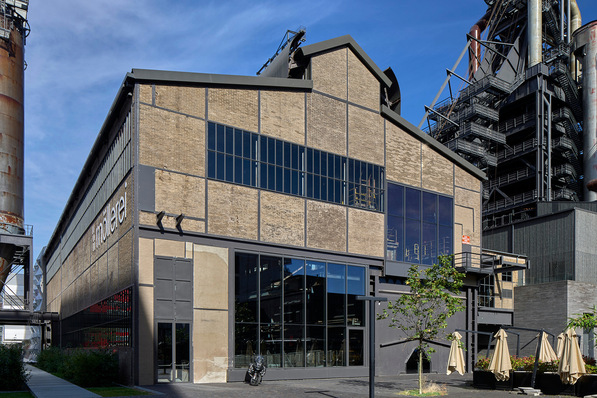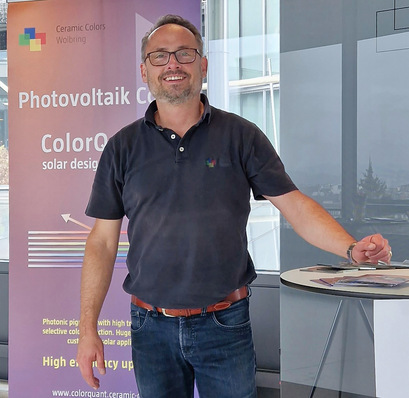An important component of the ambitious energy and sustainability concept for the Marienturm Frankfurt is the highly thermally insulated building envelope, which ensures good indoor climate conditions with high energy efficiency at all times of the year. FKN Fassaden GmbH from Neuenstein realized the approximately 1,058 square meters of mullion-transom facade and 22,280 square meters of element facade with aluminium profile systems from the German system house Hueck.
Elegant high-rise tower in the Frankfurt banking district
In terms of planning, the Berlin architectural office Thomas Müller Ivan Reimann Architects was responsible for the overall design of the Marienturm Frankfurt. “The clear, concise shape of the Marienturm gives it elegance and symbolism. Its striking shape consists of two narrow, interpenetrating panes of different heights, which structure it plastically and emphasize its verticality,” explains architect Thomas Müller. "The even structure of the facades using fine, shimmering aluminium elements ensures a homogeneous, harmonious exterior view and underlines the sculptural shape of the tower," says the architect.
System-based facade solutions tailored to the Marienturm Frankfurt

Hueck
In addition to the impressive overall aesthetic effect, the elaborate double facade also fulfils essential criteria for the LEED certification. Franz Ebert, sales manager at the metal construction company FKN, explains: “With regard to LEED, not only the demands on thermal insulation were high; an energy-efficient climate management with effective sun protection and natural ventilation was also required here”. FKN implemented the characteristic, vertically structured window facade made of glass and anodized aluminium in the entrance area with a mullion-transom construction of the Hueck Trigon 60 series. "On all other floors, the highly insulated element facade was implemented as an integrated construction with baffle plates in front and attached aluminium profiles," says Ebert.
Did you know about Hueck’s virtual showrooms? You do now!
In cooperation with the Hueck engineers, special profiles tailored to the building project were developed based on the Hueck Trigon 60 facade series and the Hueck Lambda WS 075 window series. The electrically operated sun protection in front of the window elements of the Marienturm Frankfurt is protected from wind and dirt by an externally attached baffle plate. The baffle plates in front of the triple-glazed windows also act as elegant fall protection. "The sun protection in the approximately 25 centimetre deep, ventilated space can easily be cleaned from the inside via the floor-to-ceiling window sash," explains Ebert.
Special solutions for ventilation and wind loads
The natural ventilation obligatory for the LEED certification is ensured by narrow, 1.5 meter ventilation flaps that are easy to operate from the inside. "Since the fresh air flaps open directly to the outside even at great heights, high stability and tightness were required here," says Ebert. The function of the well thought-out parallel exhibition construction by Hueck is completely invisible from the outside thanks to an attached aluminium profile.
Also in Frankfurt: Let's twist again: The Omniturm

Pecan Development
With its 38 floors, the Marienturm Frankfurt also placed some demands on the designers when it came to coping with wind loads. "One of the challenges lay in the dynamic loads that have to be compensated for by the seals on the primary level," reports Hubert Hermeling, Head of Object Management at Hueck. He further explains: "We had to implement vertical movements of 21 +/- 15 millimetres in the main elements and 38 + 13 / -33 millimetres in the special areas." The highly flexible Hueck sealing system used here not only compensates for large vertical movements, but also convinces through its particularly simple assembly.
Marienturm Frankfurt: from recyclable materials to the sustainable building
With the LEED Platinum certification, the US Green Building Council awarded the Marienturm Frankfurt the highest level of certification for sustainable buildings. The intelligently planned building envelope made a significant contribution to fulfilling the certification criteria, enabling ideal indoor climate conditions at all times of the year and thus minimizing energy costs. In addition, predominantly environmentally friendly materials and low-emission products were used. Due to its high recyclability and excellent dismantling options, aluminium, which makes up a large part of the window and facade elements, is a highly valued material in the LEED certification.













